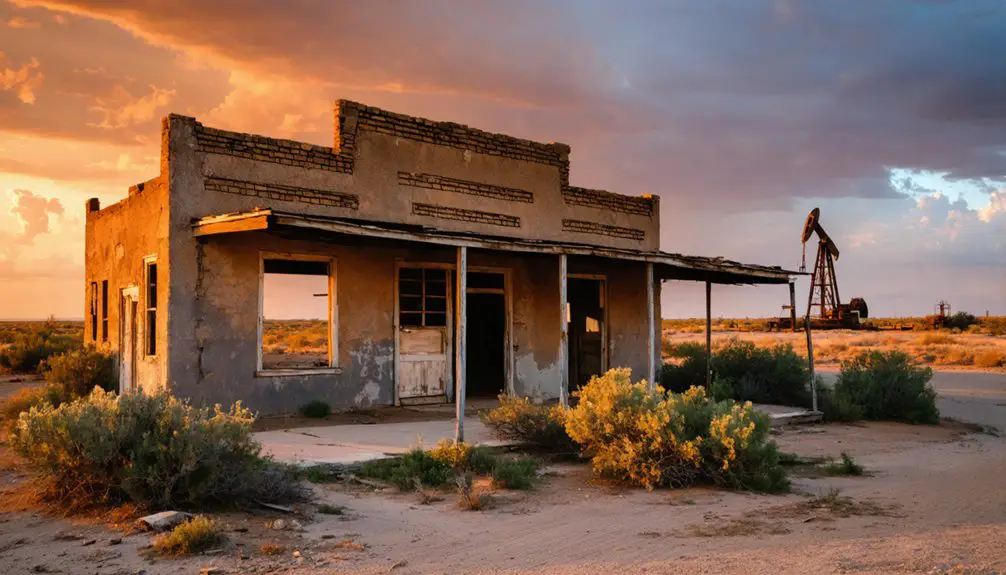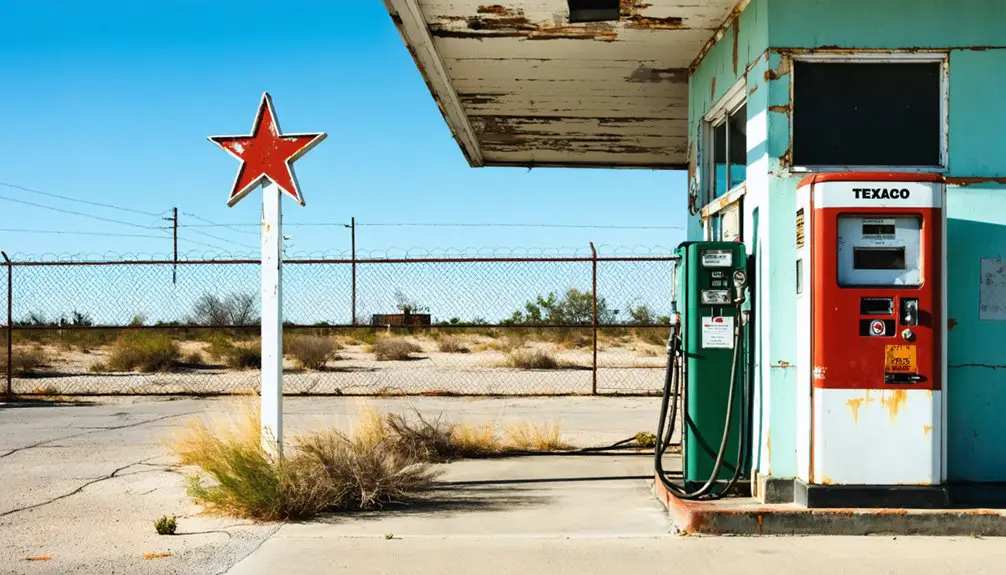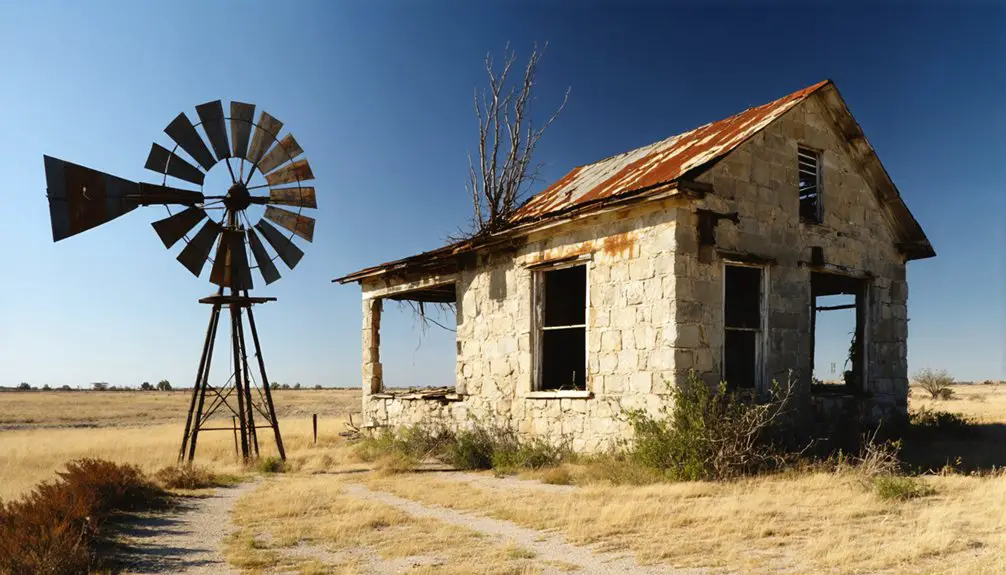You’ll find Audubon’s ghost town remains in Wise County, Texas, where it began as a promising frontier settlement in 1865. Named after naturalist John James Audubon, the town initially thrived with agriculture and D.D. Shirey’s homestead serving as a stagecoach stop. When the Fort Worth and Denver Railway bypassed Audubon in 1883, the town’s fate was sealed. After the post office closed in 1904, residents gradually abandoned the area, leaving only crumbling foundations and overgrown grass to tell its story.
Key Takeaways
- Established in 1865, Audubon was a pioneering Texas settlement named after naturalist John James Audubon with D.D. Shirey as first settler.
- The town’s decline began in 1883 when the Fort Worth and Denver Railway bypassed it, leading to economic isolation.
- Closure of the post office in 1904 marked significant population decline as residents moved to railway-connected towns like Alvord.
- Agricultural challenges, including boll weevil infestation and soil erosion, contributed to the town’s abandonment during the early 1900s.
- Currently abandoned in Wise County, only crumbling foundations and overgrown grass remain of the former settlement.
The Origins Behind Audubon’s Name
When settlers established the town of Audubon in 1865, they chose to name it after the renowned French-American naturalist John James Audubon, who’d died fourteen years earlier at his Hudson River home.
D.D. Shirey, the town’s first settler, and other educated pioneers recognized Audubon’s legacy as an influential chronicler of American bird life through his detailed paintings and studies.
Dradon and Polly Shirey made their log home into a welcoming stagecoach stop and hotel for travelers.
The decision to honor Audubon reflected the settlers’ appreciation for natural sciences and their surroundings.
While Audubon’s direct travels in Texas were limited, his naturalist influence had spread nationwide by the mid-19th century.
The abundant wildlife and natural resources of Wise County made the name particularly fitting, as it symbolically connected the settlement to Audubon’s dedicated work in documenting America’s natural world. His masterwork The Birds of America, published between 1827 and 1839, had already established itself as one of the finest bird books ever created.
Life in Early Settlement Days
Life in 1865 Audubon centered around the Shireys’ pioneering homestead, built on 160 acres of pristine Texas grasslands with waist-high native grasses and sandy soil.
You’d find their log home serving multiple roles – a hotel, stagecoach stop, and gathering place for weary travelers and locals alike.
Despite frontier hardships, you could rely on the abundant natural springs feeding local creeks, providing water for your crops and livestock.
The nearby timber offered materials for your home and fuel for winter.
Community gatherings at the Masonic lodge, operational from 1879 to 1886, helped forge strong bonds among settlers.
You’d join your neighbors for shared agricultural work and trade at the local business hub, where the spirit of cooperation defined daily life in this self-sufficient frontier settlement.
Like Cannonville’s post office, many essential services were established but eventually lost as the community changed over time.
The settlement would eventually become one of many ghost towns in Texas, reflecting the changing patterns of population and development in Wise County.
Agricultural Rise and Decline
As pioneers cleared the native grasslands in the early 20th century, Audubon’s agricultural potential emerged through conventional plowing and monoculture farming.
You’d have seen promising crop yields of cotton, corn, and wheat supporting local economic growth and settlement expansion.
However, these farming practices took their toll. Intensive plowing and continuous monoculture depleted soil health, leading to severe erosion and reduced water retention.
When the Great Depression and Dust Bowl hit, struggling farmers faced declining yields and mounting economic pressures. With grassland birds declining, the impact on local wildlife became increasingly evident.
In response, you’ll find that Audubon adapted. Farmers and ranchers shifted to conservation methods, converting cropland back to native grasslands. Similar to Burgundy Pasture Beef’s transformation of 900 plowed acres into grassland, local landowners recognized the importance of restoration.
They’ve embraced regenerative grazing techniques that restore soil fertility without heavy chemical inputs.
Today, this change represents a successful example of sustainable land management, supporting both wildlife and agricultural productivity.
The Railway’s Fateful Decision
You’ll find that the Fort Worth and Denver Railway‘s 1883 decision to bypass Audubon proved catastrophic for the town’s future.
The railway’s route selection gave nearby Alvord significant economic advantages through direct rail access, leading merchants and settlers to relocate there.
Similar to how the shift to oil by locomotives in the 1920s devastated coal-mining towns like Thurber, this fateful routing choice effectively redirected regional trade patterns away from Audubon, setting the stage for the town’s eventual decline into a ghost town.
As seen in other parts of East Texas, rail line placement had immense power to determine which communities would thrive and which would fade into history.
Railway Location Impact
The Fort Worth and Denver Railway‘s fateful decision to bypass Audubon in 1883 marked the beginning of the town’s decline.
You’ll find this choice had devastating consequences for the community’s railway transportation access, leading to economic isolation that proved insurmountable. As trains redirected their routes around Audubon, the town’s role as a regional trading center diminished rapidly.
By 1904, you could see the impact clearly when the post office closed its doors, signaling a dramatic population decrease.
While neighboring towns with railway stops flourished as vibrant trade hubs, Audubon’s exclusion from the rail network sealed its fate.
The town’s residents gradually moved away to communities with better prospects, leaving behind a once-promising settlement that would eventually become a ghost town.
Alvord’s Economic Advantage
Fort Worth and Denver Railway’s decision to establish a stop in Alvord in 1882 transformed the small settlement into a thriving economic powerhouse.
You’ll find Alvord’s advantages quickly multiplied as rail access attracted diverse businesses, growing from 35 to 62 establishments over the following decades.
The town’s economic resilience became evident through enhanced transportation efficiency, which dramatically lowered shipping costs for local farmers and merchants.
While nearby towns like Audubon withered without rail service, Alvord flourished with new sawmills, retail stores, and agricultural exports. For those seeking information about the area, the town became a primary navigation point for regional commerce and travel.
Rail contracts provided steady income through engine maintenance and track services, creating stability even during the Great Depression.
The railway’s presence sparked a self-reinforcing cycle of growth, as businesses and residents gravitated toward Alvord’s superior market access and commercial opportunities.
The success of Alvord mirrored the broader expansion of Texas railways, which reached over 6,000 miles by 1880s.
Environmental Impact and Land Changes

Since coastal habitats play a significant role in Texas’s ecosystem, Audubon Texas has spearheaded major restoration efforts to combat environmental challenges in the region. Through environmental conservation initiatives, they’ve rebuilt eroding islands using dredged sediments, creating essential rookery habitats.
Coastal restoration projects, like Chester Island’s expansion, have strengthened ecosystem resilience while protecting both wildlife and nearby communities from storm surges.
- Waterbirds soaring above newly restored nesting grounds
- Dredged material transforming barren areas into thriving island habitats
- Migratory birds finding refuge during their long journeys
- Native vegetation taking root in rebuilt coastal zones
- Storm-resistant islands standing guard against hurricane forces
You’ll find these restoration efforts particularly significant as space industry development and light pollution continue threatening these delicate ecosystems, making every acre of protected habitat invaluable for Texas’s environmental future.
The Final Years of a Dying Town
You’d find Audubon’s last businesses struggling to stay open in the early 1900s as the town’s population dwindled following the railroad bypass and agricultural failures.
The closure of the post office in 1904 marked a critical turning point, removing one of the town’s final essential services and accelerating the exodus of remaining residents.
Last Businesses Standing
As the 20th century dawned, Audubon’s once-bustling business district had dwindled to just a handful of establishments.
You’d find the general store and blacksmith shop standing as the last remaining businesses in 1903, serving the scattered local farming community.
The Bethel Baptist Church endured as one of the final community institutions, though it’s seen multiple rebuildings after weather damage.
- Clay roads leading to empty wooden storefronts
- Weathered blacksmith shop with rusty tools still hanging
- General store’s creaking porch boards and dusty windows
- White-painted Baptist church rising above abandoned lots
- Local farmers’ wagons making rare trips into town
End of Community Life
While cotton farming had sustained Audubon’s early growth, the devastating boll weevil infestation of 1888 marked the beginning of the town’s final decline. You’d have seen desperate farmers switch to peanuts, but poor land practices had already triggered severe erosion and declining soil fertility.
Community memories and social connections unraveled as key institutions vanished. You would’ve witnessed the Masonic lodge relocate to Alvord in 1886, followed by the post office closure in 1904.
The local school’s shutdown in the 1930s severed the last threads of community life. By 1937, the federal government’s purchase of surrounding land for the Panhandle National Grasslands project sealed Audubon’s fate.
As buildings were abandoned and dismantled, the once-vibrant town simply faded back into prairie, leaving only historical markers to tell its story.
Modern Day Ghost Town Status

Despite its historical settlement in 1865, Audubon stands today as a fully abandoned ghost town in Wise County, Texas. You won’t find any ghost town preservation efforts or urban development projects here – the site remains untouched by modern progress.
While a new master-planned community near Magnolia shares the Audubon name, it has no connection to this historic settlement.
- Crumbling foundations peek through overgrown grass where homes once stood
- Empty streets trace paths between long-abandoned building sites
- No utilities or infrastructure remain to support modern living
- Wild Texas landscape has reclaimed the former townsite
- Silence blankets the area where community life once thrived
Unlike some revitalized Texas ghost towns, Audubon lacks museums, tourism infrastructure, or historical programs.
The land’s ownership status remains unclear, with no plans for future development or restoration.
Frequently Asked Questions
Did Any Famous Outlaws or Notable Figures Ever Visit Audubon?
You won’t find any famous outlaws or notable figures in Audubon’s history. The town’s records, spanning from 1865 to 1904, show no documented visits from well-known personalities or criminals.
What Happened to the Original Buildings and Homes of Audubon?
Like autumn leaves scattered by time, you won’t find original buildings standing today. Without building preservation efforts, homes and businesses crumbled, leaving only the rebuilt Bethel Baptist Church and historical markers.
Were There Any Native American Settlements in the Area Before Audubon?
Yes, you’ll find rich Native American cultural heritage in the area, with Coahuiltecan, Sana, Apache, Comanche, and Waco peoples establishing settlements near water sources and along trading routes before European colonization.
How Many People Lived in Audubon During Its Peak Population?
In summary, you’d have found about 150 people living in Audubon during its peak population years. The town’s history shows this modest number before declining when the railroad bypassed it.
Did Any Other Ghost Towns Develop Near Audubon During the Same Period?
You’ll find several abandoned settlements near Audubon that emerged as ghost towns, including Mingus, which thrived on coal mining before declining in the 1930s when nearby railroad towns drew populations away.
References
- https://www.twtex.com/forums/threads/audubon-on-the-texas-grasslands.34500/
- https://kids.kiddle.co/Audubon
- https://opendata.renenyffenegger.ch/Wikimedia/Wikidata/entity/Q24260802
- https://en.wikipedia.org/wiki/List_of_ghost_towns_in_Texas
- https://tx.audubon.org/conservation/looking-back-100-years-conservation
- https://aradernyc.com/pages/natural-history-of-texas
- http://fortworthgazette.blogspot.com/2011/01/lost-north-texas-ghost-towns-places-on.html
- https://digitalcommons.usf.edu/cgi/viewcontent.cgi?article=1391&context=tos_bulletin
- https://atlas.thc.texas.gov/Details/5497000233
- https://en.wikipedia.org/wiki/Audubon



